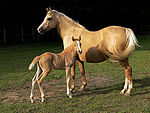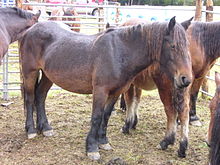- Jaca Navarra
-
Jaca Navarra
Jaca Navarra maresAlternative names Basque: Nafarroako zaldiko, Navarrese horse Country of origin Spain Breed standards Asociación de Criadores de Ganado Equino Jaca Navarra Breed standards Horse (Equus ferus caballus) The Jaca Navarra (Basque: Nafarroako zaldiko), or Navarrese horse, is a breed of small horse from the Navarre region of northern Spain. It is listed in the Catálogo Oficial de Razas de Ganado de España in the group of autochthonous breeds in danger of extinction.[1] The total population of the Jaca Navarra has been variously estimated at 350 (in 1999),[2] 250 (in 2000),[3] and 240 and decreasing (in 1997).[4] In April 2011 the total population was reported to be 899, all of which were in Navarre.[5] The breed is listed by the FAO as Endangered.[4]
A breeders' association, the Asociación de Criadores de Ganado Equino Jaca Navarra (JACANA), was formed in 1999,[2] and a breed register opened in 2001.[6] The conservation and reference herd kept in semi-feral conditions at the Sabaiza estate contains all but a few examples of the breed.[2]
Names
In Spanish, this breed is also known as the Poney Navarro, Caballo Navarro, Caballo Vasco-navarro, Caballito de Andía, Caballito de las Améscoas or Caballito de la Barranca,[2] and was in the past also known as Jaca de Montaña, Raza de Pamplona or Raza Pamplonica.[6]
The word jaca has an unusual history, from Old Spanish haca, itself from Old French haque, which in turn is ultimately derived from the English place-name Hackney, a place famous for its horses.[7]
See also
- Iberian horse
- Basque breeds and cultivars
References
- ^ "Ganaderia: Clasificación de Razas". Ministerio de Medio Ambiente y Medio Rural y Marino. (in Spanish). http://aplicaciones.mapa.es/arca-webapp/flujos.html?_flowId=razaCaballar-flow&_flowExecutionKey=e4s1. Retrieved August 2011.
- ^ a b c d "Raza Jaca Navarra" (in Spanish). ITG Ganadero. http://www.itgganadero.com/itg/portal/seccion.asp?S=3&P=17&N=79. Retrieved Apr 2011.
- ^ Cañon, J; Checa ML, Carleos C, Vega-Pla JL, Vallejo M, Dunner S (February 2000). "The genetic structure of Spanish Celtic horse breeds inferred from microsatellite data". Anim. Genet. 31 (1): 39–48. PMID 10690360. http://www3.interscience.wiley.com/resolve/openurl?genre=article&sid=nlm:pubmed&issn=0268-9146&date=2000&volume=31&issue=1&spage=39. Retrieved Apr 2011.
- ^ a b Scherf, Beate D. (ed.) (2000). World Watch List for Domestic Animal Diversity. Rome: Food and Agriculture Organization of the United Nations. p. 739. ISBN 92-5-104511-9. ftp://ftp.fao.org/docrep/fao/009/x8750e/x8750e.pdf.
- ^ "Ganaderia: Raza equino caballar JACA NAVARRA". Click on JACA NAVARRA in the EQUINO CABALLAR section, then Datos Censales tab. Ministerio de Medio Ambiente y Medio Rural y Marino (in Spanish). http://aplicaciones.mapa.es/arca-webapp/flujos.html?_flowId=catalogoRazas-flow&_flowExecutionKey=e2s1#1002. Retrieved Apr 2011.
- ^ a b "Ganaderia: Raza equino caballar JACA NAVARRA". Click on JACA NAVARRA in the EQUINO CABALLAR section. Ministerio de Medio Ambiente y Medio Rural y Marino (in Spanish). http://aplicaciones.mapa.es/arca-webapp/flujos.html?_flowId=catalogoRazas-flow&_flowExecutionKey=e2s1#1002. Retrieved Apr 2011.
- ^ "DICCIONARIO DE LA LENGUA ESPAÑOLA". REAL ACADEMIA ESPAÑOLA. http://buscon.rae.es/draeI/SrvltConsulta?TIPO_BUS=3&LEMA=jaca. Retrieved 7 April 2011.
Equine Equine science and
management
Equestrianism
and sportGlossary of equestrian terms · List of Equestrian Sports · Horse tack · Bit · Bridle · Saddle · Harness · English riding · Western riding · Driving · Horse training · Horse racing · Equestrian at the Summer Olympics (medalists, venues) · Horse show · EquitationEvolution and history Domestication · In warfare · In the Middle Ages · Horses in East Asian warfare · History of the horse in South Asia · Horses in the Napoleonic Wars · Horses in World War I · Horses in World War II · History of the horse in BritainHorse breeds, types
and other EquidaeList of horse breeds · Wild horse · Feral horse · Stock horse · Gaited horse · Draft horse · Warmblood · Sport horse · List of horse breeds in DAD-ISOther EquusHybrids
This horse-related article is a stub. You can help Wikipedia by expanding it.


